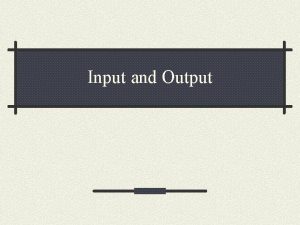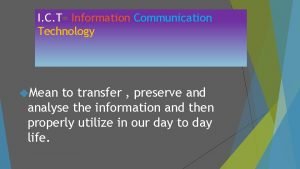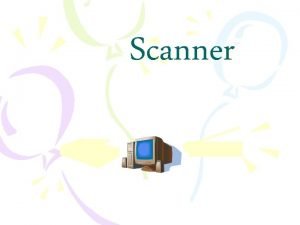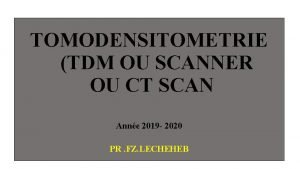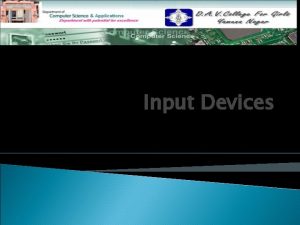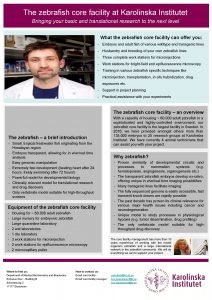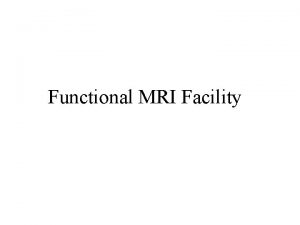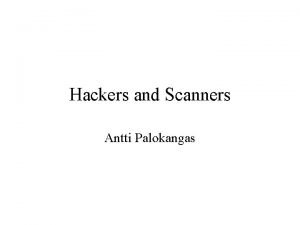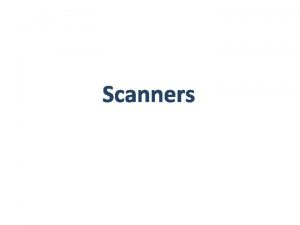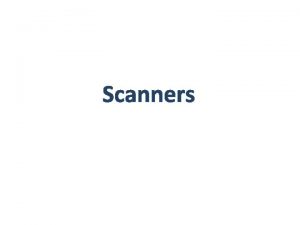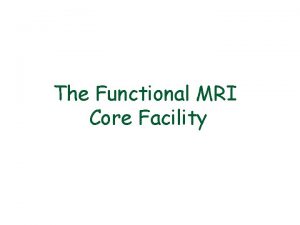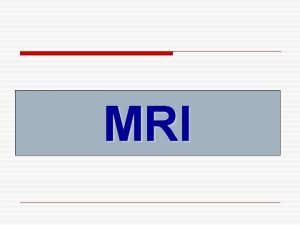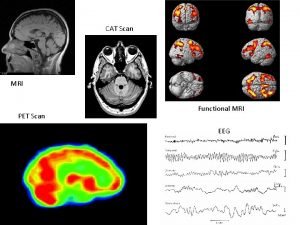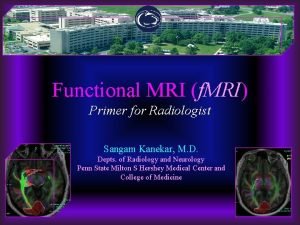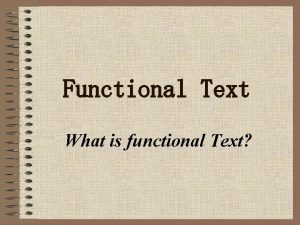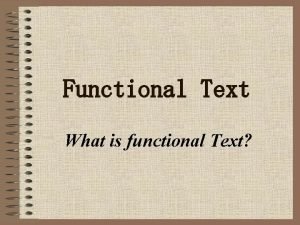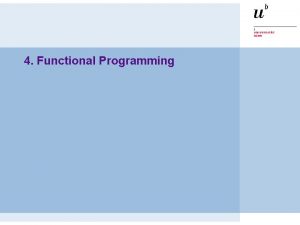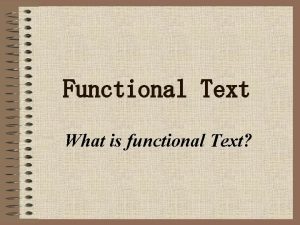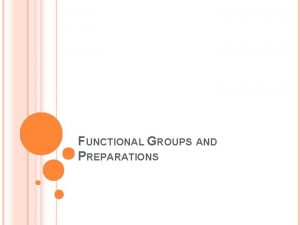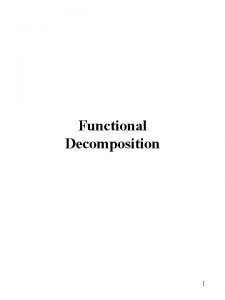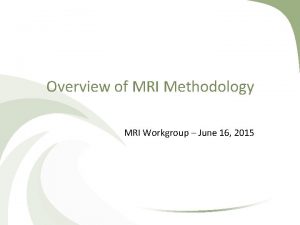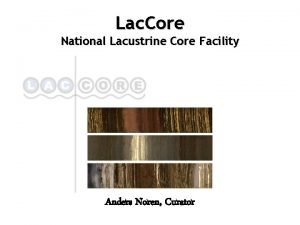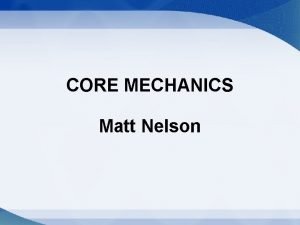The Functional MRI Core Facility MRI Scanners June


































- Slides: 34

The Functional MRI Core Facility

MRI Scanners: June November September January November July 2000 2002 2004 2007 2007 “ 3 T-1” GE 3 T “ 3 T-2” GE 3 T “FMRIF 1. 5 T” GE 1. 5 T 3 T -1 decommissioned “ 3 T-A” GE 3 T “ 3 T-B” GE 3 T “ 3 T-2” named “ 3 T-C” 3 T-C upgraded to HD.

1. 5 T 3 T-A 3 T-B 3 T-C

Staff: Peter Bandettini, Ph. D. – Director Sean Marrett, Ph. D. – Staff Scientist Jerzy Bodurka, Ph. D. – Staff Scientist Wen-Ming Luh, Ph. D. – Staff Scientist Vinai Roopchansinch, Ph. D. -Staff Scientist Adam Thomas – IT Specialist Kay Kuhns – Administrative Lab Manager Janet Ebron – Technologist Ellen Condon – Technologist Sahra Omar – Technologist Paula Rowser – Technologist Chung Kan – Technologist Debbie Tkaczyk -Technologist Sandra Moore -Technologist Marcela Montequin -Technologist

Users NIMH: Peter Bandettini, Ph. D. Chris Baker, Ph. D. Karen Berman, M. D. James Blair, Ph. D. Mary Kay Floeter, M. D. , Ph. D. Jay Giedd, M. D. Christian Grillon, Ph. D. Wayne Drevets, M. D. Ellen Liebenluft, M. D. Alex Martin, Ph. D Mort Mishkin, Ph. D Elizabeth Murray, Ph. D Daniel Pine, M. D. Judith Rapaport, M. D. Jun Shen, Ph. D. Susan Swedo, M. D. Leslie Ungerleider, Ph. D. Daniel Weinberger, M. D. NINDS: Leonardo Cohen, M. D. Jeff Duyn, Ph. D. Jordan Grafman, Ph. D. Mark Hallet, Ph. D. John Hallenbeck, M. D. Alan Koretsky, Ph. D. Christy Ludlow, Ph. D. Henry F. Mc. Farland, M. D. Edward Oldfield, M. D. William Theodore, M. D. NICHD: Peter Basser, Ph. D. Allen Braun, M. D. NCI: Kathy Warren, M. D.

Services: 1. State of the art MRI technology. 2. Maintenance and support of daily MRI scanner operation. 3. Trained MRI technologist coverage during all prime time hours and most off hours and weekends. 4. Training by technologists in scanning techniques and protocols. 5. Updated scheduling and a means for exchanging scan time between users. 6. The FMRIF website (http: //fmrif. nimh. nih. gov/). 7. Weekly f. MRI discussion groups that focus on recent research and issues. 8. State of the art subject interface devices. 9. Short and long term automatic archiving of f. MRI data. 10. Consulting with users on the best f. MRI scanning and processing approaches.

Summary: Inception: Current annual budget (2009): Personnel budget: Supplies, equipment and services budget: # of staff: # of Principle Investigators Served: # of active protocols using FMRIF: # of subjects scanned per year: 1999 $2. 21 M $1. 76 M $450 K* 15 34 60 5000 *excludes maintenance contracts (rises to $890 K next year when maintenance is included)


Scopus: Articles or Reviews Published per Year “f. MRI” or “functional MRI”

Type of f. MRI research perfor Motor Primary Sensory Integrative Sensory Basic Cognition High-Order Cognition Emotion J. Illes, M. P. Kirschen, J. D. E. Gabrielli, Nature Neuroscience, 6 (3) p. 205, 2001

What f. MRI Is Currently Being Used For Research Applications -map networks involved with specific behavior, stimulus, or performance -characterize changes over time (seconds to years) -determine correlates of behavior (response accuracy, etc…) -characterization of groups or individuals Clinical Research -clinical population characterization (probe task or resting state) -assessment of recovery and plasticity -attempts to characterize (classify) individuals Clinical Applications -presurgical mapping (CPT code in place as of Jan, 2007)

Technology Coil arrays High field strength High resolution Novel functional contrast Fluctuations Dynamics Spatial patterns Interpretation Methodology Functional Connectivity Assessment Multi-modal integration Pattern classification Real time feedback Task design (f. MRIa…) Basic Neuroscience Behavior correlation/prediction Pathology assessment Applications

7 T 11. 7 T 3 T - C

The Challenge Regarding the New 7 T To create a robust, user-friendly system (Staff of physicists who have benefited from the experience of Jeff Duyn’s group) • Field inhomogeneities are greater (and vary more over space and time) • RF power is higher (limits certain sequences) • RF penetration is less homogeneous (inhomogeneous images) • T 2* is shorter (less time for DTI, multi-echo, high res) • T 1 is longer (have to go to longer TR) • Fluctuations are greater



Why High Field? • Increased SNR • Increased functional and anatomical contrast • New contrasts • Higher resolution • Shorter scan times (wider range of patients and studies) • Better sensitivity to fluctuations (i. e. connectivity) • More information from individuals (rather than group averaging)

Higher SNR 7 T 3 T TSE, 11 echoes, 7 min exam, 20 cm FOV, 512 x 512 (0. 4 mm x 0. 4 mm), 3 mm thick slices. white matter SNR = 65 Gray matter SNR = 76 white matter SNR = 26 Gray matter SNR = 34 Courtesy of L. Wald, MGH, Boston

Novel Contrast Duyn et al. PNAS, 2007

Orientation Columns in Human V 1 as Revealed by f. MRI at 7 T Phase Map 0° Yacoub, et al. PNAS, 2008 Phase 180° Scalebar = 0. 5 mm

Temporal Signal to Noise Ratio (TSNR) vs. Signal to Noise Ratio (SNR) 3 T, birdcage: 2. 5 mm 3 3 T, 16 channel: 1. 8 mm 3 7 T, 16 channel: 1. 4 mm 3 J. Bodurka, F. Ye, N Petridou, K. Murphy, P. A. Bandettini, Neuro. Image, 34, 542 -549 (2007)

Scanning Individuals K. Murphy, J. Bodurka, P. A. Bandettini, How long to scan? The relationship between f. MRI temporal signal to noise and the necessary scan duration. Neuro. Image, 34, 565 -574 (2007)

Multi-sensory integration M. S. Beauchamp et al. , Visual Auditory Multisensory

Object categories are associated with distributed representations in ventral temporal cortex Haxby et al. 2001

Boynton (2005), News & Views on Kamitani & Tong (2005) and H

Lower spatial frequency clumping Kamitani & Tong (2005)


Pattern Information Mapping From fixed ROI N. Kriegeskorte, E. Formisano, B. Sorger, R. Goebel, Proc. Nat'l. Acad. Sci. USA, 104, 20600 -20605 (2007)

Dissimilarity Matrix Creation 96 0 dissimilarity 96 matrix 0 0 0 compute dissimilarity (1 -correlation across space) response patterns . . . ROI in Brain stimuli N. Kriegeskorte, et al, Neuron, 60, 1126 -1141 (2008) . . . 96

Visual Stimuli

Human IT Human Early Visual Cortex 00 visually most responsive(1057 voxels) visually most responsive voxel

average of 4 subjects fixation-color task 316 voxels average of 2 monkeys fixation task >600 cells

Resting state networks identified with ICA M. De. Luca, C. F. Beckmann, N. De Stefano, P. M. Matthews, S. M. Smith, f. MRI resting state networks define distinct modes of long-distance interactions in the human brain. Neuro. Image, 29, 1359 -1367

Real time f. MRI feedback to reduce chronic pain Control over brain activation and pain learned by using real-time functional MRI, R. C. de. Charms, et al. PNAS, 102; 18626 -18631 (2005)
 Scanners produce text and graphics on a physical medium
Scanners produce text and graphics on a physical medium Light-sensing input device that reads printed text
Light-sensing input device that reads printed text Flachbettscanner aufbau
Flachbettscanner aufbau Echelle de hounsfield
Echelle de hounsfield Literary device scanner
Literary device scanner Zebrafish core facility
Zebrafish core facility Functional and non functional
Functional and non functional Space maintainer definition
Space maintainer definition Functional and non functional plasma enzymes
Functional and non functional plasma enzymes Enzymes of blood plasma
Enzymes of blood plasma Layers of earth from most dense to least dense
Layers of earth from most dense to least dense Core rigidities
Core rigidities Inner core and outer core
Inner core and outer core Compare and contrast the crust mantle and core
Compare and contrast the crust mantle and core Sự nuôi và dạy con của hổ
Sự nuôi và dạy con của hổ đại từ thay thế
đại từ thay thế Vẽ hình chiếu vuông góc của vật thể sau
Vẽ hình chiếu vuông góc của vật thể sau Công thức tiính động năng
Công thức tiính động năng Thế nào là mạng điện lắp đặt kiểu nổi
Thế nào là mạng điện lắp đặt kiểu nổi Tỉ lệ cơ thể trẻ em
Tỉ lệ cơ thể trẻ em Lời thề hippocrates
Lời thề hippocrates Vẽ hình chiếu đứng bằng cạnh của vật thể
Vẽ hình chiếu đứng bằng cạnh của vật thể Phản ứng thế ankan
Phản ứng thế ankan Quá trình desamine hóa có thể tạo ra
Quá trình desamine hóa có thể tạo ra Môn thể thao bắt đầu bằng chữ f
Môn thể thao bắt đầu bằng chữ f Sự nuôi và dạy con của hươu
Sự nuôi và dạy con của hươu điện thế nghỉ
điện thế nghỉ Dot
Dot Nguyên nhân của sự mỏi cơ sinh 8
Nguyên nhân của sự mỏi cơ sinh 8 Trời xanh đây là của chúng ta thể thơ
Trời xanh đây là của chúng ta thể thơ Chó sói
Chó sói Thiếu nhi thế giới liên hoan
Thiếu nhi thế giới liên hoan Fecboak
Fecboak Các châu lục và đại dương trên thế giới
Các châu lục và đại dương trên thế giới Một số thể thơ truyền thống
Một số thể thơ truyền thống
